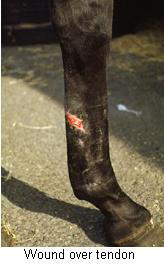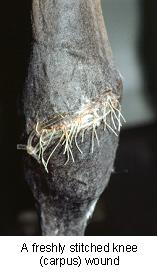
- posted: Jun. 27, 2023
Horses and ponies often receive cuts and other wounds particularly on their face and legs. Many require just simple first aid measures, while others require the attention of your veterinarian. Simple first aid measures can help reduce the risk of infection or further damage.
Basic First Aid Kit
Your first aid kit should contain the following items:
- Sterile non-stick dressings (3.94" x 3.94" or 3.94" x 7.87" sizes) (10 x 10 cm or 10 x 20 cm)
- Cotton wool or Gamgee roll
- Bandaging materials including self adhesive sticky and non-sticky bandages
- Spare clean stable bandage
- Small bottle of disinfectant, such as Betadine, Hibiscrub, Savlon or Dettol etc.
- Bandage/scissors
- Wound poultice dressing
- Antibiotic wound spray and/or wound powder
What should I do first?
If your horse has sustained a cut or wound the most important thing to do is to stop the bleeding. This can be done by applying direct pressure to the wound using a clean piece of Gamgee roll or cotton wool, either held or bandaged in place until the bleeding has stopped or your veterinarian has arrived. Tourniquets are less favored now because of the risk of causing thromboses (blood clots) in the veins and arteries. If there is foreign material protruding from the wound, pressure should be applied immediately above and around the wound. This can be done by hand or where possible by creating a ring of bandaging material so that pressure can be applied to the surrounding area without applying any more pressure to the foreign body. If this is small and can safely be removed, it is best removed. Always tell your veterinarian if you have removed a foreign body, and keep it for his or her examination, as he or she will wish to make sure that no more foreign material is left more deeply in the wound.
If an artery or vein has been cut it may take 20 minutes to half an hour for the bleeding to stop. In some cases of arterial bleeding, this cannot be stopped until the artery has been clamped or tied off by a veterinarian and in such cases it is important to continue to apply pressure until he or she arrives. Once bleeding has stopped or if the wound has not bled excessively it should be cleaned to reduce the risk of infection. Be gentle and careful not to re-start the bleeding. Liberal dowsing with water, using a hose, is effective at flushing off dirt and debris and helping to minimize swelling and inflammation. Cold water also helps to stem bleeding.
Minor wounds can be cleansed using a dilute solution of disinfectant. If the wound is in an amenable area, a non-stick dressing should be applied, covered with a piece of cotton wool or Gamgee roll and held in place by a self adhesive bandage. If the wound is large or deep or there has been extensive bleeding your veterinarian should be called. While waiting for your veterinarian the wound should be left covered where possible. Wounds on the upper limbs, body and head, not amenable to bandaging, should just be cleaned and left open or continually cold-hosed. Do not apply wound powder or ointment just in case the wound needs stitching, unless your veterinarian is going to be delayed, when it is helpful to cover the wound with anti-bacterial ointment such as Betadine or Savlon just to keep the tissues soft and help prevent them from drying out. Some improvisation may be called for in the presence of large skin flaps such as those which may occur on the belly or upper limb. With these wounds it may be necessary to try to use clean towels or sheets held in place with bandaging materials just to try to prevent further damage occurring to the skin and underlying tissues.
Which types of wounds need stitching?
Wounds that penetrate the full thickness of the skin or deeper, wounds on the nostrils, lips and eyelids, wounds where a flap of skin has been created and wounds where underlying tissues have been exposed should always be seen by a veterinarian as in most instances they will require suturing. Small wounds however, even if full thickness can very often be left unsutured. Most heal uneventfully. If your horse has a wound that you think may require suturing it is important to call your veterinarian as soon as possible. Wounds sutured within 4 hours of occurrence tend to heal much more successfully that those that are repaired later, after the tissues have started to dry out. When sutured later, wounds may have already developed a considerable amount of swelling, are therefore less amenable to suturing, and are more susceptible to the development of complications.
Small skin wounds on the lower legs of horses, i.e., below the knees or hocks, are often best left unsutured, but cleaned and bandaged because they tend to swell if sutured. In some cases such wounds are partially sutured, leaving the lower aspect of the wound open to drain into the bandage. In some cases if a horse is hospitalized and the wound is very carefully and thoroughly cleaned, prepared and sutured under general anesthetic, followed by expert wound dressing and bandaging, results may be excellent. Decisions on wound management should be made on the basis of the individual wound, horse and owner aspirations. Significant advances have been made in the treatment of equine wounds over the last few years.
Wounds over joints, tendon sheaths and penetrating body cavities
Wounds involving joints and tendon sheaths are always potentially life-threatening as infection in these structures can be extremely difficult to resolve even if undertaken very quickly. Inflammatory responses can result in joint surface or sheath membrane damage and, with associated infections, can cause long term or permanent incapacity. If unsure whether a wound has penetrated a joint or sheath, your veterinarian may wish to take a sample of joint or sheath fluid (joint or sheath tap) to test the cell count and the appearance of the cell types (cytopathology) to determine if the joint or sheath will require to be flushed with large quantities of sterile saline solution and antibiotics to remove the associated infection, its toxins and the inflammatory proteins. The sooner this is done following injury the better the chances for a successful recovery. Your veterinarian may wish to take x-ray pictures of the area to make sure that there are no fractures and to look for demonstrable foreign bodies.
Similarly, penetrating wounds into the chest and abdomen may cause immediate death or serious life-threatening complications. Wounds into the chest affect a horse's ability to breathe and will result in the development of pleuropneumonia. Penetrating wounds into the abdominal cavity will result in the development of peritonitis and may cause damage to any of the internal organs. These cases, if resolvable, will need intensive treatment. Your veterinarian should be called immediately, stressing the emergency nature of the injury.
Tetanus Protection
Any wound can result in contamination with environmental bacteria, that may include Clostridium tetani, and your horse developing tetanus. This is a particular risk if the injury has been a puncture wound and the skin surface has closed over relatively quickly, resulting in the air-less conditions in which these bacteria like to grow and produce their toxins. Every horse should be fully and regularly vaccinated against tetanus, to reduce the risk of this disease and avoid the worry that minor wounds may result in such unnecessary complications. Tetanus vaccine is initially administered on two occasions a month apart. A third vaccine is given at 12 months and booster vaccinations are given every 24 months. In most cases this vaccination regime can be combined with that for influenza and there are no excuses for not taking advantage of this life-saving vaccine.
Contributors: Deidre M. Carson, BVSc, MRCVS & Sidney W. Ricketts, LVO, BSc, BVSc, DESM, DipECEIM, FRCPath, FRCVS.
Edited by Kim McGurrin BSc DVM DVSc Diplomate ACVIM
© Copyright 2010 Lifelearn Inc. Used and/or modified with permission under license.

Office Hours
Closed for lunch 12pm to 1pm. For afterhours call 306-378-2252 for the emergency veterinarian on call.
8:00 am - 5:00 pm
8:00 am - 5:00 pm
8:00 am - 5:00 pm
8:00 am - 5:00 pm
8:00 am - 5:00 pm
Closed
Closed

